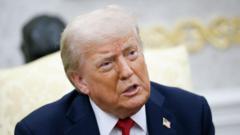Trump stated that the U.S. would coordinate with NATO allies to ensure that Ukraine receives "top-of-the-line weapons" from European states, with crucial elements including missiles and ammunition, all vital for Ukraine's defense against Russian aggression. At a press meeting with NATO Secretary General Mark Rutte in Washington, Trump emphasized the need for Ukraine to assert its autonomy and military capabilities. Rutte confirmed that European countries would supply Ukraine with their air defense systems, with the U.S. providing replacements.
In a bold economic warfare move, Trump indicated that a 100% secondary tariff would be levied against countries trading with Russia, especially targeting those that continue to buy Russian oil. For instance, if India persists in its dealings with Moscow, any goods shipped to the U.S. from India would incur significant tariffs, discouraging those transactions. This strategy aims to choke off revenue for Russia, which heavily relies on oil exports to fund its military efforts in Ukraine.
Despite these stern warnings, the Moscow Stock Exchange rose in response to Trump’s announcement, as investors had anticipated even tougher measures. While specifics remain unclear, this marks the first major military commitment from Trump following his return to office.
The rhetoric surrounding Ukraine and its conflict with Russia has intensified, with Trump expressing frustration over the lack of progress toward peace negotiations. Emphasizing that communication has not translated into action, he criticized past interactions with Putin and the resultant military escalation against Ukraine.
With ongoing discussions between Ukrainian President Zelensky and U.S. envoy Keith Kellogg, the international community watches closely, particularly for responses from the Kremlin. Early reactions from pro-Kremlin figures suggest skepticism about the effectiveness of the proposed tariffs, while others argue that the geopolitical winds could shift in unpredictable ways in the coming weeks.
In a bold economic warfare move, Trump indicated that a 100% secondary tariff would be levied against countries trading with Russia, especially targeting those that continue to buy Russian oil. For instance, if India persists in its dealings with Moscow, any goods shipped to the U.S. from India would incur significant tariffs, discouraging those transactions. This strategy aims to choke off revenue for Russia, which heavily relies on oil exports to fund its military efforts in Ukraine.
Despite these stern warnings, the Moscow Stock Exchange rose in response to Trump’s announcement, as investors had anticipated even tougher measures. While specifics remain unclear, this marks the first major military commitment from Trump following his return to office.
The rhetoric surrounding Ukraine and its conflict with Russia has intensified, with Trump expressing frustration over the lack of progress toward peace negotiations. Emphasizing that communication has not translated into action, he criticized past interactions with Putin and the resultant military escalation against Ukraine.
With ongoing discussions between Ukrainian President Zelensky and U.S. envoy Keith Kellogg, the international community watches closely, particularly for responses from the Kremlin. Early reactions from pro-Kremlin figures suggest skepticism about the effectiveness of the proposed tariffs, while others argue that the geopolitical winds could shift in unpredictable ways in the coming weeks.




















